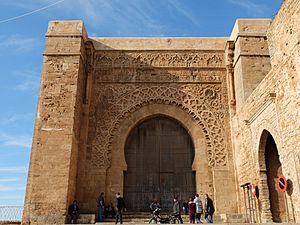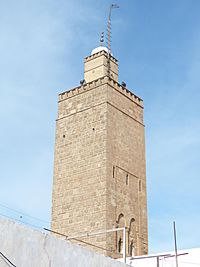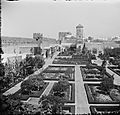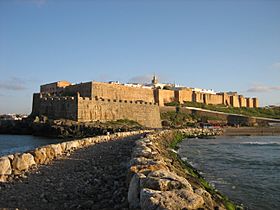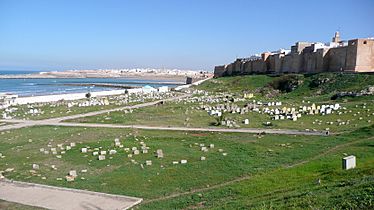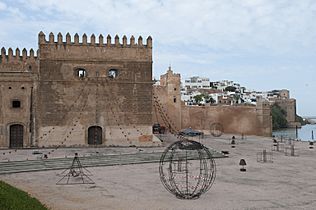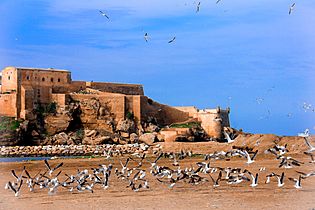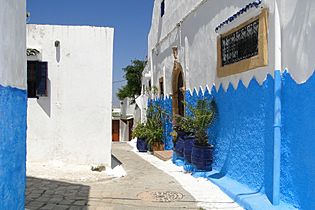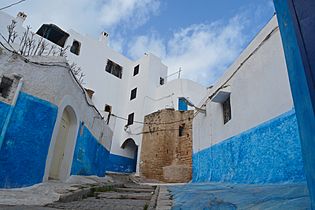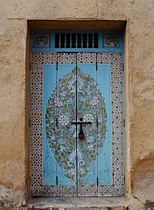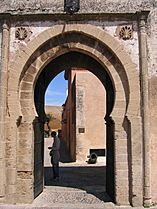Kasbah of the Udayas facts for kids
Quick facts for kids Kasbah of the Udayas |
|
|---|---|
| Native name قصبة الوداية (Arabic) ⵇⵙⴱⴰ ⵏ ⵉⵡⴷⴰⵢⵏ (Berber) |
|
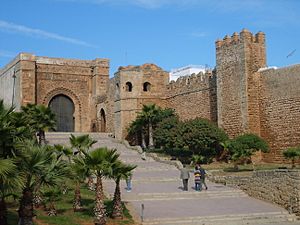
The walls of the kasbah and the main Almohad gate, Bab Oudaia.
|
|
| Type | Kasbah |
| Location | Rabat, Morocco |
| Built | 12th century |
| Architectural style(s) | Moroccan |
| Lua error in Module:Location_map at line 420: attempt to index field 'wikibase' (a nil value). | |
|
Part of a series on the
|
|---|
| History of Morocco |
 |
|
|
Classical to Late Antiquity
(8th century BC – 7th century AD) |
|
|
|
|
|
|
Related topics
|
The Kasbah of the Udayas (also called Kasbah of the Oudaias) is an old fortress, or kasbah, in Rabat, Morocco. It sits on a hill right where the Bou Regreg river meets the ocean. Across the river is the city of Salé. The Kasbah is also next to Rabat's old city, called the Medina quarter. This amazing place is part of a UNESCO World Heritage Site, along with other important spots in Rabat.
Contents
What's in a Name?
The original name for this fortress was Qasbat al-Awdāya. The word Awdāya is the plural of wadi, which means "river valley." Over time, people in Morocco started saying al-Widaya instead of al-Awdāya.
A Look Back: The Kasbah's History
Early Beginnings
Around the 10th century, a group called the Umayyads from Spain, or their friends, built a small fort here. It was a ribat, like a fortified outpost, to protect against other groups. This first fort was probably on the same spot as the Kasbah today.
Later, in the 12th century, a ruler named Tashfin ibn Ali built a new ribat here. But another powerful group, the Almohad Caliphate, defeated him and destroyed his fort.
The Almohad Era
Around 1150, the Almohad leader Abd al-Mu'min built a new kasbah (fortress) on the same site. He added a palace and a mosque inside. He even had an underground canal dug to bring water, which helped people settle there.
Later, another Almohad leader, Yaqub al-Mansur (who ruled from 1184 to 1199), started a huge project. He wanted to build a new capital city called al-Mahdiyya or Ribat al-Fath. This new city would cover a large area, including the old kasbah. He also planned a giant mosque (you can still see its remains in the Hassan Tower) and grand gates. Two of these gates were Bab er-Rouah and what we now call Bab Udaya or Bab al-Kbir.
However, after Ya'qub al-Mansur died in 1199, the city and mosque were never finished. The kasbah itself became mostly empty for a while.
The Republic of Salé and Pirates
In 1609, a king in Spain ordered all the Moriscos to leave. Moriscos were people of Muslim heritage who had been forced to convert to Christianity. About 2,000 of these refugees came to this area and settled in the kasbah. Many more Moriscos joined them, making the population between 5,000 and 14,000 people.
These Moriscos created their own independent area called the Republic of Salé. It became a base for corsairs, also known as the "Salé Rovers." These pirates attacked merchant ships in the Atlantic Ocean and often sold the crews into slavery.
During this time, in the early 17th century, they built a wide platform on the kasbah's edge overlooking the river. It was used for sending signals. Later, a warehouse was added, which is now a school and a carpet workshop. They also built a sqala (a seaside fort with cannons) and the "Tower of the Corsairs" to surprise enemy ships. The Republic of Salé was independent until 1666, when the 'Alawi sultan Moulay Rashid took control.
The 'Alawi Period
The southwestern part of the Kasbah was built later, especially in the 18th century. Sultan Moulay Ismail (who ruled from 1672 to 1727) built a royal palace there, which is now a museum. Moulay Ismail also brought a tribe called the Udayas (or Oudayas) to live in the kasbah. They were a "military tribe" who served in the sultan's army.
However, the Kasbah only became known as "Udaya" in the 19th century. This happened after the tribe was moved there permanently by Sultan Abd ar-Rahman.
World Heritage Site
The Kasbah, along with Rabat, was added to the UNESCO World Heritage list in 2006. It officially became a World Heritage Site in 2012, recognized for its important history and culture.
Key Buildings and Sights
The Kasbah has two main parts. The upper, northern part is older, mostly from the 12th-century Almohad period. The lower, southern parts were built later, in the 18th-century 'Alawi period. The northern part has the Street of the Mosque, which leads to the Old Mosque. The southern part has the beautiful Andalusian Gardens, the Oudayas Museum, and a popular café.
The Great Gate of the Kasbah (Bab Oudaya)
The main gate of the kasbah is called Bab Oudaia ("Udaya Gate") or Bab al-Kbir ("Great Gate"). It's considered one of the most beautiful gates in Moroccan architecture. It was built by the Almohad leader Ya'qub al-Mansur between 1195 and 1199.
The gate has detailed carvings on both its outer and inner sides. The designs include geometric shapes and patterns, as well as a Qur'anic inscription in Kufic Arabic script. There are also unique "S"-shaped carvings that look like eels, which are very rare in this type of architecture. Inside, the gate has three rooms that form a winding passage.
The Old Mosque (Mosque of the Kasbah)
The oldest building still standing in the Kasbah is its main mosque, called the Jama' al-'Atiqa ("Old Mosque"). It was first built in 1150. It was largely rebuilt in the 18th century by an English corsair named Ahmed el-Inglizi. The tall, square minaret (tower) you see today is from this later restoration.
The mosque has a rectangular courtyard surrounded by covered walkways. The prayer hall has rows of arches. Like many old mosques in this region, its prayer direction (qibla) faces mostly south, not directly towards Mecca. The inside walls are white, with colorful Moroccan tilework and carved stucco designs. The mihrab (a niche showing the prayer direction) is especially decorated.
One interesting thing about this mosque is that its minaret used to be separate from the main building. It was only connected to the mosque in 1940.
Oudayas Museum (Moulay Ismail's Pavilion)
The southern part of the kasbah has a former palace built by Sultan Moulay Ismail in the late 17th century. This building is now a museum. It has a main courtyard and a distinctive tower.
In 1915, during the time of the French protectorate in Morocco, this palace was turned into a museum. It became an ethnographic museum, showing off different cultures and ways of life. The collection grew to include jewelry, musical instruments, pottery, old Qur'ans, clothes, silks, and carpets from all over Morocco. In 2006, after being restored, it became the National Jewellery Museum. In 2014, the museum closed for more updates.
-
The tower of the pavilion of Moulay Ismail (Oudayas Museum)
-
The main courtyard of the residential pavilion of Moulay Ismail, now part of the Oudayas Museum
Andalusian Garden
Next to the museum, you'll find the beautiful "Andalusian Garden." It was created between 1915 and 1918. This garden is designed in the style of Moorish gardens from al-Andalus (southern Spain). It has many different trees and plants, like bougainvillea and citrus trees. It's a popular spot for both tourists and local people to relax.
The Kasbah Today
Today, the Kasbah is a very popular place to visit in Rabat. It offers amazing views of the waterfront, the Bou Regreg river, the city of Salé, and the Atlantic Ocean. Most of the Kasbah is a residential neighborhood, famous for its distinctive blue and white walls. A nearby open area is sometimes used for concerts during the annual Mawazine music festival.
Gallery
-
The Kasbah of the Udayas overlooking the Bou Regreg River
-
View of the Kasbah, including the minaret of the Old Mosque
See also
 In Spanish: Qasba de los Udayas para niños
In Spanish: Qasba de los Udayas para niños
- Lists of mosques
- List of mosques in Africa
- List of mosques in Morocco


